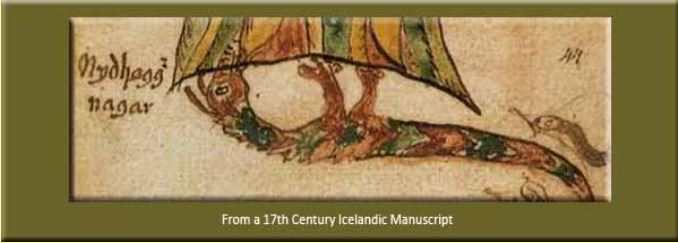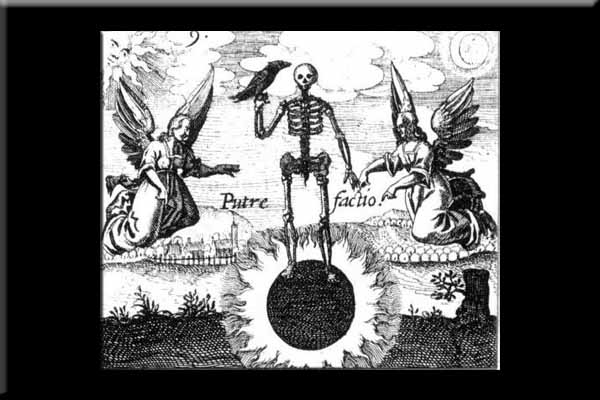The Serpent Nidhogg, Corpses and the Nigredo
You gotta hand it to the Norse myth-makers — a huge serpent eating corpses and gnawing at the root of the World Tree is a bit of a nightmare image.
According to Jung, the beginning of psychological work starts with the alchemical stage of the nigredo, the “point of maximum despair.” In images, it is associated with death, blackness, ravens, rotting corpses, the black sun.

In Norse myth, Nidhogg (“tearer of corpses”) is a monstrous serpent that gnaws almost perpetually at the deepest root of the World Tree Yggdrasil, threatening to destroy it. The serpent is always bickering with the eagle that houses in the top of the tree. Nidhogg lies on Nastrond in Niflheim and eats corpses to sustain itself.
Nidhogg or Nidhoggr is the Dragon, which inhabits the underworld Niflheim {dark world} in Norse mythology. The name Nidhogg has been variously translated as ‘striking full of hatred‘ and ‘dread biter’.
Living by the root of Yggdrasill the World Ash, in a pit of serpents, Nidhogg feeds on the bodies of the dead at Hvergelmir {the bubbling cauldron} the spring in Niflheim which is the source of the rivers of the world. When not feeding upon the dead Nidhogg gnaws at the root of Yggdrasill and sends taunting messages to the eagle perched in its high branches via the squirrel Ratatosk. Ratatosk in turn brings the eagles taunts back to Nidhogg.
In the act of gnawing the root, Nidhogg joins the four stags Dainn, Dvalinn, Duneyr and Durathor who graze the leaves and bark of Yggdrasill higher up.
Nidhogg rises at Ragnarok, bringing up the corpses of the dead to join battle. The dragon however survives to continue its existence in the new order that follows. Sources have suggested that Nidhogg’s continued presence in the new world is to provide an evil balance to the new good
 Alchemy represents the projection of a drama both cosmic and spiritual in laboratory terms. The ‘opus magnum’ had two aims: the rescue of the human soul and the salvation of the cosmos . . This work is difficult and strewn with obstacles; the alchemical opus is dangerous. Right at the beginning you meet the “dragon,” the chthonic spirit, the “devil” or, as the alchemists called it, the “blackness,” the nigredo, and this encounter produces suffering. . .In the language of the alchemists, matter suffers until the nigredo disappears…
Alchemy represents the projection of a drama both cosmic and spiritual in laboratory terms. The ‘opus magnum’ had two aims: the rescue of the human soul and the salvation of the cosmos . . This work is difficult and strewn with obstacles; the alchemical opus is dangerous. Right at the beginning you meet the “dragon,” the chthonic spirit, the “devil” or, as the alchemists called it, the “blackness,” the nigredo, and this encounter produces suffering. . .In the language of the alchemists, matter suffers until the nigredo disappears…
In psychological terms, the soul finds itself in the throes of melancholy, locked in a struggle with the ‘shadow’. The mystery of the coniunctio, the central mystery of alchemy, aims precisely at the synthesis of opposites, the assimilation of the blackness, the integration of the devil. (Jung, 1952 interview with Mircea Eliade in Combat)
